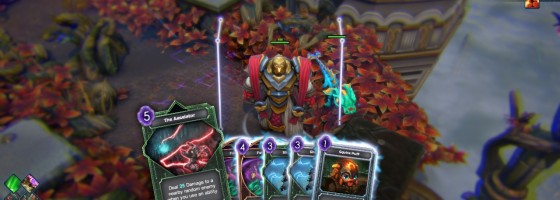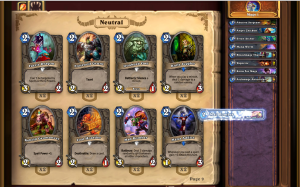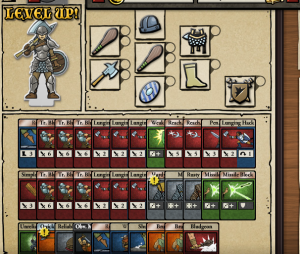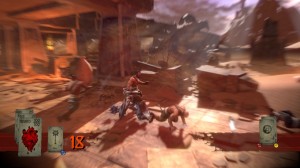Trending
Opinion: How will Project 2025 impact game developers?
The Heritage Foundation's manifesto for the possible next administration could do great harm to many, including large portions of the game development community.

Featured Blog | This community-written post highlights the best of what the game industry has to offer. Read more like it on the Game Developer Blogs or learn how to Submit Your Own Blog Post
Today's post looks at the concept of adding in CCG-based design into other games, and what works and doesn't work with it.

Recently I tried out Forced: Showdown which combined light ARPG play with CCG mechanics to great effect. The use of CCG mechanics is another option in the Game Designer's toolbox to create great games from, but it's important to understand the limitations and rewards for such a game design.
More...

Before we begin, it's important to briefly define the types of games we're talking about. CCG-based games are when a designer either directly takes CCG mechanics and functionality and adds it to a game design, or uses the concept of CCG game design as a foundation or source of growth of their game's mechanics.
That means we're not going to be focusing on Hearthstone, Magic the Gathering or any other CCG in this post. Talking about CCG-based game design, there are several elements that we see indicative of this style.
A big part of CCGs is letting the player personalize their experience. The most straight forward approach is having a deck or deck-like system that the player picks and chooses from. In both Forced: Showdown and Hand of Fate, the player must create a deck that their character will draw from while playing a game.
We can take this and abstract it to games that let the player define a build or strategy from a selection of preset abilities and powers. The big point is that the player has a limit: They cannot use everything at once and must decide what to have available. In this case, Diablo 2 would not be an example of a CCG-based system, but Diablo 3 with the ability to pick and choose skills, runes and passives would be.

Hearthstone
CCG-styled games give the player a lot of flexibility in deciding how they want to play with the options availableA really good example of this would also be in Age of Empires 3 and the Home City mechanic: Where players defined a "deck" of passive and active abilities they could make use of during a match.
The ability to create your own style and build a potential strategy has always been a major allure of CCG design; compared to games where the progression path is kept the same no matter what.
Since there is a hard limit of what you can have access to, it gives the player enough options to create something unique, while still limiting them from having access to everything.
This kind of control can also extend to being able to affect the game's difficulty. You can introduce modifiers that either increase of decrease the difficulty of the game; giving the player the option to get more or less rewards in the process. Bastion was a great example of this, and the designers made sure that each difficulty modifier would radically impact playing the game instead of just being stat modifiers.
Given all the possible cards/options, it's important to keep things straightforward, which is another positive of CCG design.
One of the elements that keep CCGs popular today is how accessible they can be; incidentally, this translates into their popularity for game designers for paper prototyping along with board game design. Rules of CCG design require that everything must be explained at the high level of thinking: No large numbers, no advanced formulas, just simple rules that can be combined for great effect.
Card Hunter is a good example of this. The game gives the player tons of cards to choose from and to keep an eye on from the enemy's side. The interactions between the cards are very straight forward and follow CCG's design of black and white results. If a card says that it's going to do five points of damage, then it's going to do five points of damage unless the opposing player has a card that gets around it.

Card Hunter
Despite featuring a lot of options and rules, CCG-based games are easy to learn thanks to their black and white mechanicsThe idea of "rule changing," or how different cards interact with each other is a major element of high-level CCG play. This is where advanced deck building to play off of different card abilities come in to create a hopefully winning strategy.
The final advantage also has to do with deck building, and that is the allure of quality cards.
Anyone who has played a CCG can tell you about the allure of rare or higher quality cards. In some cases higher quality cards are just better than the regular ones; with unique art to boot.
In some games, rarer cards aren't better, but allow for more strategies and synergies than you would with just the common cards. Hearthstone for instance, saves the more complex rules and strategies for the rarer cards and legendary category.
That hunt for rare cards also helps to keep people playing the game; for finding new cards and to try out said cards in their deck. This is one of the reasons why CCG-based mechanics work so well for multiplayer titles, as the combination of playing against people and the hunting for new cards or items are a great one-two punch for replayability.
This also has an impact on extending the game with new cards or content; a great game can keep growing for a very long time. While CCG mechanics do a lot to boost a game's design and replayability, it's not without problems or risks to keep in mind.
Using CCG-based mechanics in your title means that you are locked into the design for the foundation of your game design. What that means is that you cannot deviate from it or add in any content that would supersede the design. Because of that, we tend to see gameplay built around CCG design to be on the simplistic side.
Both Forced: Showdown and Hand of Fate's minute-to-minute gameplay are on the simple side. You'll find that in many CCG-based titles, there is never a growth of the base game systems over the length of the game; what you see in the first few minutes is going to be it for the entirety of the game.
The point is that the meta-game of the CCG mechanics and designing your build are supposed to be the meat of the experience. However, when your game is built around a limited number of set choices, it becomes very easy for hardcore experts to find the best ways to play. Hearthstone has had that trouble dealing with flavor of the month decks and those that became the de facto choice for tournament play. Diablo 3 also suffers from this; with the end game all about getting sets completed and nothing else to shoot for.
Speaking of the best way to play, that takes us to the next challenge and when it comes time to balance your design.
CCG-based games and game mechanics are some of the trickiest games to balance and fine-tune. Simply changing the cost of a card by one point can mean monumental changes to your entire game and to the Meta. What's worse is when new cards are introduced to the game in order to keep it growing. Every new card added runs the risk of making a previous card obsolete and punishing people who aren't spending money or playing the game day in and day out to get those new cards.

Hand of Fate
It's hard to balance your actual gameplay sometimes with the ccg-based mechanics due to how much the game's design is built around the CCGWith Hearthstone and the changing Meta, I remember how the first expansion introduced cards that became standard choices, and you were severely punished if you didn't have those cards while playing ranked.
And there is also a lot of talk about the recent changes Blizzard is doing to a lot of the original cards that were in Hearthstone. Again, they may only be changing things by one cost or one attack for the most part, but even just one point means big deals for the Meta.
While the more CCG elements you have in your game can be a good thing, they also introduce more chaos to your design and can impact the balance and difficulty.
CCG and CCG design tend to add randomization to a game's design; the player never knows what's going to be thrown at them or what their potential strategies are at any given moment. Unfortunately, that makes coming up with a gradual difficulty curve almost impossible.
You're never going to know exactly what the player is going to have or what the enemy is going to use during a battle. Because of this, someone may have every play be easy as hell, and someone else may get stuck within minutes. This is what happened to me in Card Hunter. I did not get any good cards and found myself outmatched by battles that were supposed to be even to my level. My only choices were to either keep grinding and hope for a miracle draw, or keep playing and hope that the game would give me cards that would help.
This also makes it very frustrating to try and learn a game or improve at it. How does the player know that what they're doing is incorrect, or that it's simply the RNG making life difficult for them? The answer is that they will never know, and their only option is to keep playing and hope for a different outcome.
Finally, the last risk or problem with CCG-based mechanics has to do with replaying the game. Now I know that I said that replayability was a pro in the previous section, but having the player keep coming back to play can come back to bite the developer.
The reason is that it can become a chore to play a game with CCG-mechanics if the player is trying to actively improve their deck or options. Since RNG is a factor, they need to hope that they will get cards or options that they can use or are better than what they have. If they don't get anything, that will lead to hours of grinding (and wasting money) in the hopes of getting something to improve.
In Marvel Puzzle Quest for instance, just getting a new character wasn't enough. The only way to get a character to the point where you could make use of them for high level play was to keep finding "covers" for each of their skills. If you didn't get the covers that you needed, then the character remained weaker and was a liability for using them. I think you can guess what was the only way to get those covers: Spending money and/or in-game resources to get a random draw.

Marvel Puzzle Quest
CCG-mechanics work really well in free to play games, but can make progress very frustrating if you don't spend any moneyUnless the player can get lucky with finding the content that they will need, progression can just stop until that luck comes through. Going back to the earlier points, because the game's design is built around the CCG Meta, there is usually no other way for the player to improve or make a difference.
Nothing hurts more than playing through a match or game, and finding that you unlocked nothing that will help you; effectively wasting your time.
CCG-based design can be used in a variety of implementations as we've talked about. Not only that, but the design philosophy works really well with microtransactions and free to play design; making them attractive for multiplayer-based titles.
There is just a lot work needed to get the design to fit properly and making something with the ability to grow the foundation, as CCG-based mechanics will live or die based on how the developers are able to grow and continue supporting the game.
The reason is that since you’re dealing with set values and options for upgrades, without further updates, top choices will be figured out and renders the game's challenge moot. When it works, CCG-based design can create great games with a lot of depth, while still providing something easy to start, but difficult to master.
(For posts and podcasts on game design and the industry, check out Game-Wisdom, along with the Youtube channel for daily videos. And my Patreon campaign to help keep Game-Wisdom ad free, while continuing to put out great content.)
Read more about:
Featured BlogsYou May Also Like